Morphometric Study of Mus musculus, Rattus norvegicus, and Rattus rattus in Qatar
Abstract
:Simple Summary
Abstract
1. Introduction
2. Materials and Methods
2.1. Study Season, Area, and Rodent Collection
2.2. Rodent Identification and Morphometric Assessment
2.3. Statistical Analysis
3. Results
3.1. Demographic Information
3.2. Morphometric Assessments of Rodents
4. Discussion
5. Conclusions
Author Contributions
Funding
Institutional Review Board Statement
Informed Consent Statement
Data Availability Statement
Acknowledgments
Conflicts of Interest
References
- Wilson, D.E.; Reeder, D.M. Mammal Species of the World: A Taxonomic and Geographic Reference; Johns Hopkins University Press: Baltimore, MD, USA, 2005. [Google Scholar]
- Rabiee, M.H.; Mahmoudi, A.; Siahsarvie, R.; Kryštufek, B.; Mostafavi, E. Rodent-borne diseases and their public health importance in Iran. PLoS Negl. Trop. Dis. 2018, 12, e0006256. [Google Scholar] [CrossRef] [Green Version]
- Burgin, C.J.; Colella, J.P.; Kahn, P.L.; Upham, N.S. How many species of mammals are there? J. Mammal. 2018, 99, 1–14. [Google Scholar] [CrossRef] [Green Version]
- Puckett, E.E.; Orton, D.; Munshi-South, J. Commensal Rats and Humans: Integrating Rodent Phylogeography and Zooarchaeology to Highlight Connections between Human Societies. BioEssays 2020, 42, 1900160. [Google Scholar] [CrossRef] [Green Version]
- Etougbétché, J.; Houémènou, G.; Dossou, H.-J.; Badou, S.; Gauthier, P.; Abdou Karim, I.Y.; Nicolas, V.; Dobigny, G. Genetic diversity and origins of invasive black rats (Rattus rattus) in Benin, West Africa. J. Vertebr. Biol. 2020, 69, 1–11. [Google Scholar] [CrossRef]
- Puckett, E.E.; Park, J.; Combs, M.; Blum, M.J.; Bryant, J.E.; Caccone, A.; Costa, F.; Deinum, E.E.; Esther, A.; Himsworth, C.G.; et al. Global population divergence and admixture of the brown rat (Rattus norvegicus). Proc. R. Soc. B Biol. Sci. 2016, 283, 20161762. [Google Scholar] [CrossRef] [PubMed] [Green Version]
- Ventura, J.; López-Fuster, M. Morphometric analysis of the black rat: Rattus rattus, from Congreso Island (Chafarinas Archipiélago, Spain). Orsis Org. Sist. Rev. Botànica Zool. Ecol. 2000, 15, 91–102. [Google Scholar]
- Boratyński, Z.; Brito, J.C.; Campos, J.C.; Cunha, J.L.; Granjon, L.; Mappes, T.; Ndiaye, A.; Rzebik-Kowalska, B.; Serén, N. Repeated evolution of camouflage in speciose desert rodents. Sci. Rep. 2017, 7, 3522. [Google Scholar] [CrossRef] [Green Version]
- Odigie, A.E.; Ekeolu, K.O.; Asemota, D.O.; Uwagie-Ero, E.A.; Aighewi, I.T.; Ighedosa, S.U.; Usifoh, S.F.; Olugasa, B.O.; Asemota, O.; Fagboya, T.E. Comparative non-metric and morphometric analyses of rats at residential halls of the University of Benin campus, Nigeria. J. Infect. Public Health 2018, 11, 412–417. [Google Scholar] [CrossRef]
- Food and Agricultural Organization. Irrigation in the Near East Region in Figures; Food and Agriculture Organization of the United Nations: Rome, Italy, 1997. [Google Scholar]
- World Travel Guide. Qatar Weateher, Climate and Geography. 2020. Available online: https://www.worldtravelguide.net/guides/middle-east/qatar/weather-climate-geography/ (accessed on 11 July 2020).
- Food and Agricultural Organization. Arid ZoneF: A Guide for Field Technicians; Food and Agriculture Organization of the United Nations: Rome, Italy, 1989. [Google Scholar]
- Noureldin, E.M.; Farrag, H. Rodent control strategy in animal farms (izzab) in Qatar. In Proceedings of Qatar Foundation Annual Research Forum; Hamad Bin Khalifa University Press: Doha, Qatar, 2010; Volume 2010, p. EEP31. [Google Scholar]
- Veterinary Laboratory. Necropsy Records in the Pathology Unit: 2017–2020; Department of Animal Resources, Ministry of Municipality and Environment: Doha, Qatar, 2021. [Google Scholar]
- Dubey, J.P.; Pas, A.; Rajendran, C.; Kwok, O.C.H.; Ferreira, L.R.; Martins, J.; Hebel, C.; Hammer, S.; Su, C. Toxoplasmosis in Sand cats (Felis margarita) and other animals in the Breeding Centre for Endangered Arabian Wildlife in the United Arab Emirates and Al Wabra Wildlife Preservation, the State of Qatar. Vet. Parasitol. 2010, 172, 195–203. [Google Scholar] [CrossRef] [PubMed]
- Abu-Madi, M.A.; Behnke, J.M.; Prabhaker, K.S.; Al-Ibrahim, R.; Lewis, J.W. Intestinal helminths of feral cat populations from urban and suburban districts of Qatar. Vet. Parasitol. 2010, 168, 284–292. [Google Scholar] [CrossRef]
- Ghunaim, H.; Behnke, J.M.; Aigha, I.; Sharma, A.; Doiphode, S.H.; Deshmukh, A.; Abu-Madi, M.M. Analysis of resistance to antimicrobials and presence of virulence/stress response genes in Campylobacter isolates from patients with severe diarrhoea. PLoS ONE 2015, 10, e0119268. [Google Scholar] [CrossRef] [PubMed]
- Humphrey, J.M.; Ranbhise, S.; Ibrahim, E.; Al-Romaihi, H.E.; Farag, E.; Abu-Raddad, L.J.; Glesby, M.J. Multiplex Polymerase Chain Reaction for Detection of Gastrointestinal Pathogens in Migrant Workers in Qatar. Am. J. Trop. Med. Hyg. 2016, 95, 1330–1337. [Google Scholar] [CrossRef] [Green Version]
- Abu-Madi, M.A.; Behnke, J.M.; Mikhail, M.; Lewis, J.W.; Al-Kaabi, M.L. Parasite populations in the brown rat Rattus norvegicus from Doha, Qatar between years: The effect of host age, sex and density. J. Helminthol. 2005, 79, 105–111. [Google Scholar] [CrossRef]
- Abu-Madi, M.A.; Lewis, J.W.; Mikhail, M.; El-Nagger, M.E.; Behnke, J.M. Monospecific helminth and arthropod infections in an urban population of brown rats from Doha, Qatar. J. Helminthol. 2001, 75, 313–320. [Google Scholar] [CrossRef] [PubMed]
- Records of Pest Control Unit; Ministry of Municipality and Environment: Doha, Qatar, 2020.
- Mills, J.N.; Childs, J.E.; Ksiazek, T.G.; Peters, C.J.; Velleca, W.M. Methods for Trapping and Sampling Small Mammals for Virologic Testing; U.S. Department of Health & Human services, Public Health Services, Centers for Disease Control and Prevention: Atlanta, GA, USA, 1995.
- Cunningham, D.M.; Moors, P.J. Guide to the Identification and Collection of New Zealand Rodents, 3rd ed.; Science Publications, Department of Conservation: Wellington, New Zealand, 1996. [Google Scholar]
- Darvish, J.; Mohammadi, Z.; Mahmoudi, A.; Siahsarvie, R. Faunistic and taxonomic study of Rodents from northwestern Iran. Iran. J. Anim. Biosyst. 2014, 10, 119–136. [Google Scholar]
- Krystufek, B.; Vohralík, V. Mammals of Turkey and Cyprus: Rodentia II: Cricetinae, Muridae, Spalacidae, Calomyscidae, Capromyidae, Hystricidae, Castoridae; Znanstveno-raziskovalno sredisce Republike Slovenije: Koper, Slovenia, 2009. [Google Scholar]
- The University of Arizona. Cleaning and Preserving Animal Skulls. Available online: https://extension.arizona.edu/sites/extension.arizona.edu/files/pubs/az1144.pdf (accessed on 26 December 2020).
- Kawakami, M.; Yamamura, K.-I. Cranial bone morphometric study among mouse strains. BMC Evol. Biol. 2008, 8, 73. [Google Scholar] [CrossRef] [Green Version]
- Breno, M.; Leirs, H.; Van Dongen, S. Traditional and geometric morphometrics for studying skull morphology during growth in Mastomys natalensis (Rodentia: Muridae). J. Mammal. 2011, 92, 1395–1406. [Google Scholar] [CrossRef]
- Krutzsch, P.H. North American Jumping Mice (Genus Zapus); University of Kansas: Lawrence, KS, USA, 1954. [Google Scholar]
- George, D.; Mallery, P. SPSS for Windows Step by Step: A Simple Guide and Reference, 13.0 Update; Pearson Education A&B: Boston, MA, USA, 2006. [Google Scholar]
- Trochim, W.M.K. Research Methods Knowledge Base. Available online: https://conjointly.com/kb/ (accessed on 26 December 2020).
- Moorhead, L.C. Effects of Rodents on Ecosystem Structure and Function. Ph.D. Thesis, University of Tennessee, Knoxville, TN, USA, 2017. Available online: https://trace.tennessee.edu/cgi/viewcontent.cgi?article=5789&context=utk_graddiss (accessed on 26 December 2020).
- Al Thani, M.A. Irkaya; Ministy of Environment Qatar: Doha, Qatar, 2015.
- Amori, G.; Hutterer, R.; Kryštufek, B.; Yigit, N.; Mitsain, G.; Palomo, L.J.; Aulagnier, S. Jaculus Jaculus (Amended Version of 2016 Assessment), 2021. The IUCN Red List of Threatened Species. 2021, e.T10912A197517244. Available online: https://dx.doi.org/10.2305/IUCN.UK.2021-1.RLTS.T10912A197517244.en (accessed on 28 May 2021).
- Farag, E.; Sikkema, R.S.; Vinks, T.; Islam, M.M.; Nour, M.; Al-Romaihi, H.; Al Thani, M.; Atta, M.; Alhajri, F.H.; Al-Marri, S.; et al. Drivers of MERS-CoV Emergence in Qatar. Viruses 2018, 11, 22. [Google Scholar] [CrossRef] [Green Version]
- Mahmoudi, A.; Kryštufek, B.; Darvish, J.; Aliabadian, M.; Tabatabaei Yazdi, F.; Yazdani Moghaddam, F.; Janžekovič, F. Craniometrics are not outdated: Interspecific morphological divergence in cryptic arvicoline rodents from Iran. Zool. Anz. 2017, 270, 9–18. [Google Scholar] [CrossRef]
- Yiğit, N.; Çolak, E.; Sözen, M.; Özkurt, Ö. The Taxonomy and Karyology of Rattus norvegicus (Berkenhout, 1769) and Rattus rattus (Linnaeus, 1758) (Rodentia: Muridae) in Turkey. Turk. J. Zool. 1998, 22, 203–212. [Google Scholar]
- Keshtkar, S.; Katouzian, A.-R.; Rajabi-Maham, H.; Yousefi, Z. Morphometric Study of Genus Rattus in Tehran City. J. Am. Sci. 2012, 8, 220–224. [Google Scholar]
- Ben Faleh, A.; Annabi, A.; Said, K. Morphometric variation in black rat rattus rattus (Rodentia: Muridae) from Tunisia. Acta Zool. Bulg. 2012, 64, 381–387. [Google Scholar]
- Shad, H.; Darvish, J. Rodents diversity in Protected areas of Yazd Province, Central of Iran. J. Res. Biol. 2018, 1. [Google Scholar] [CrossRef]
- Humphries, M.M. Chapter 10-Mammal Ecology as an Indicator of Climate Change. In Climate Change; Letcher, T.M., Ed.; Elsevier: Amsterdam, The Netherlands, 2009; pp. 197–214. [Google Scholar] [CrossRef]
- Ashton, K.G.; Tracy, M.C.; Queiroz, A. Is Bergmann’s Rule Valid for Mammals? Am. Nat. 2000, 156, 390–415. [Google Scholar] [CrossRef]
- Alhajeri, B.H.; Steppan, S.J. Association between climate and body size in rodents: A phylogenetic test of Bergmann’s rule. Mamm. Biol. 2016, 81, 219–225. [Google Scholar] [CrossRef]
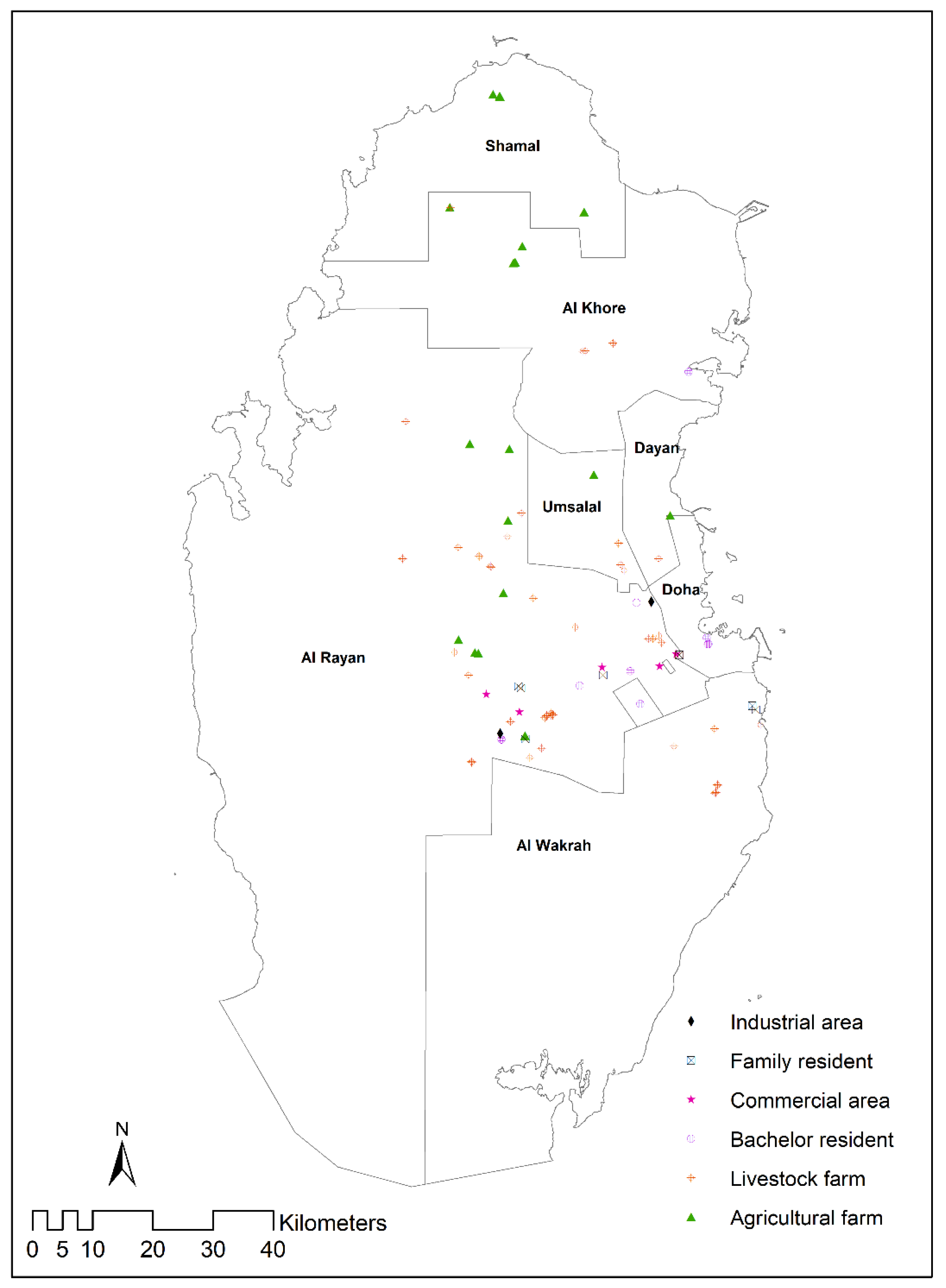
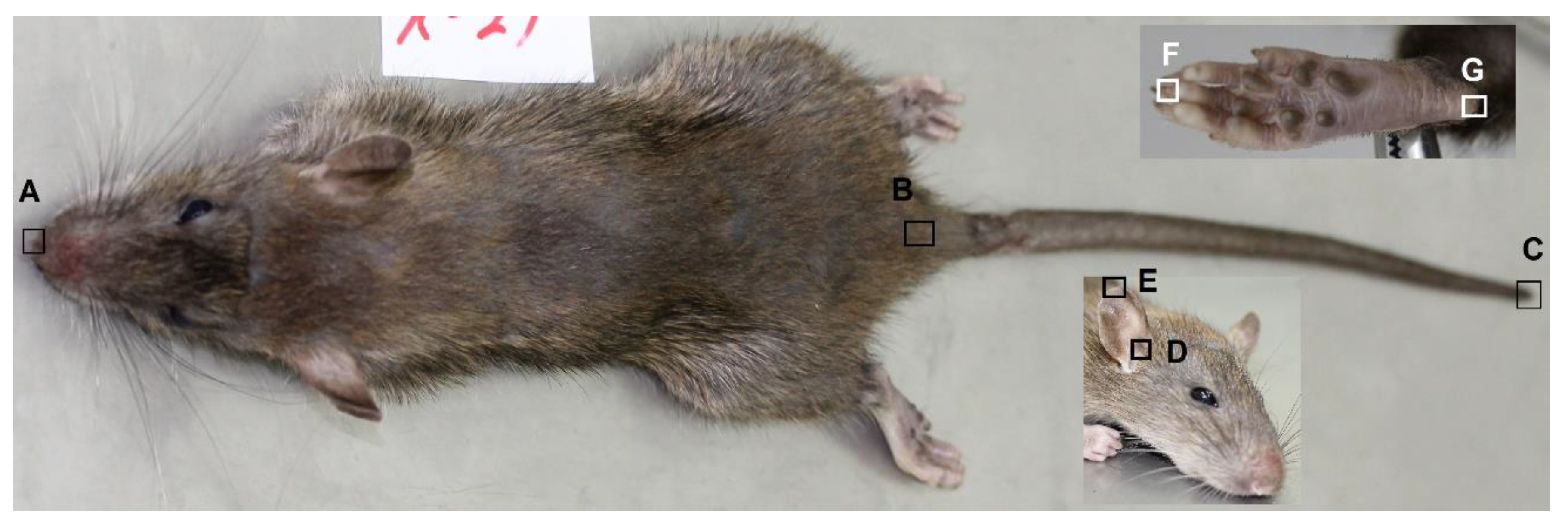
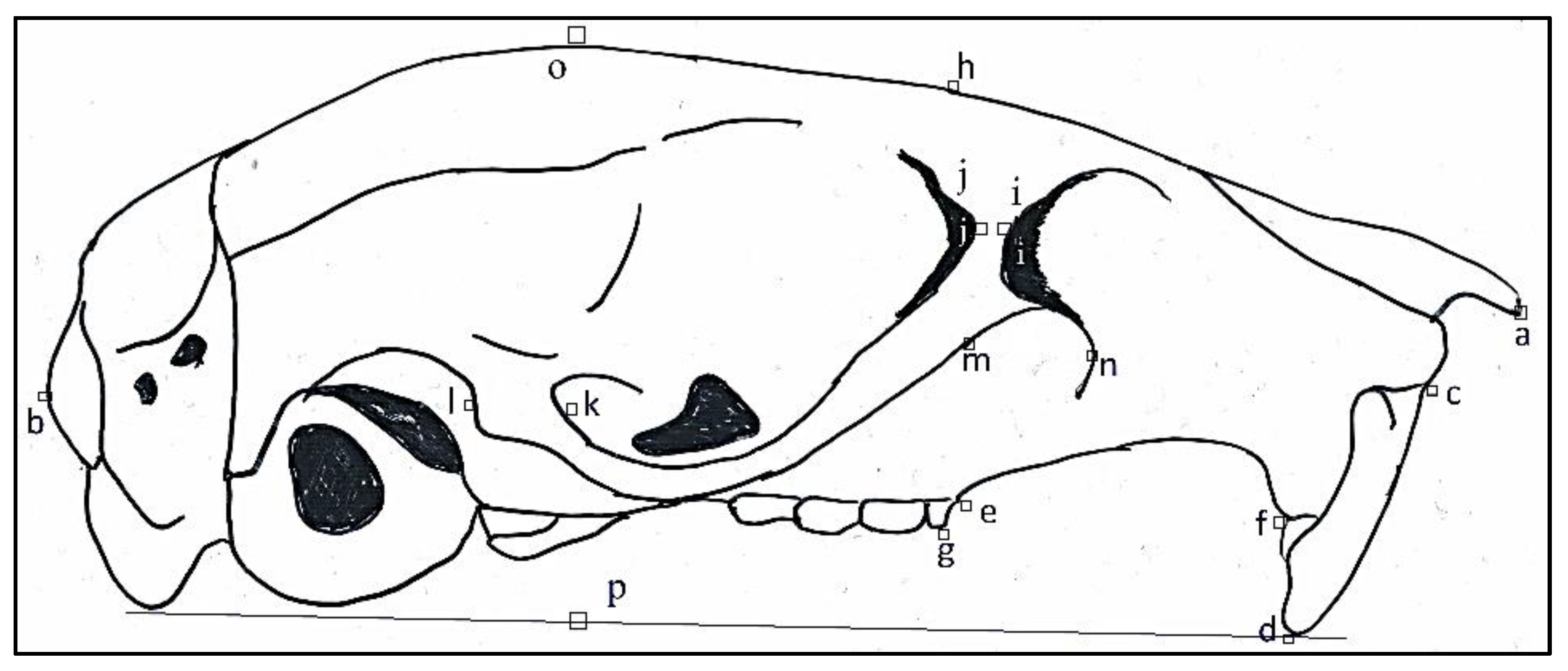
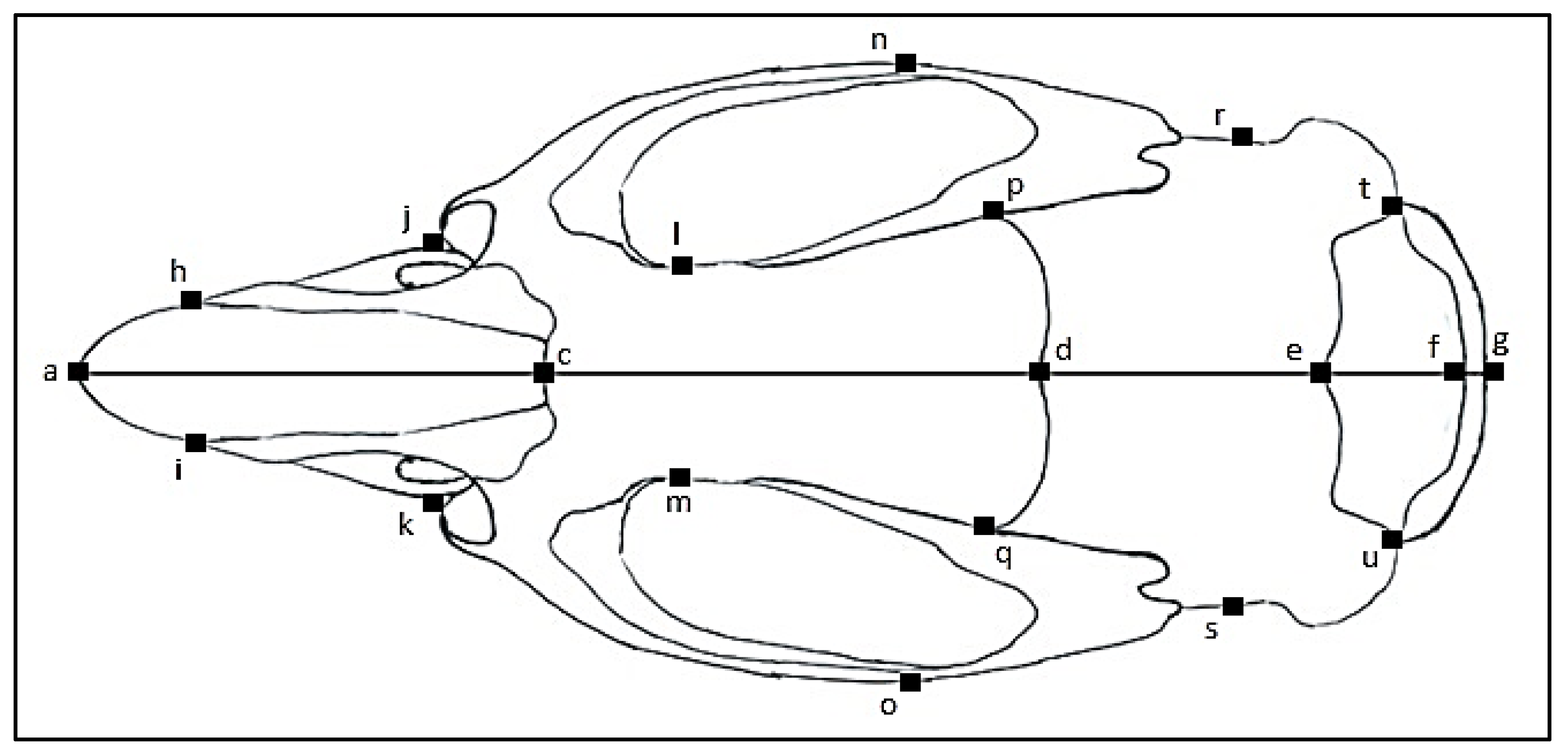
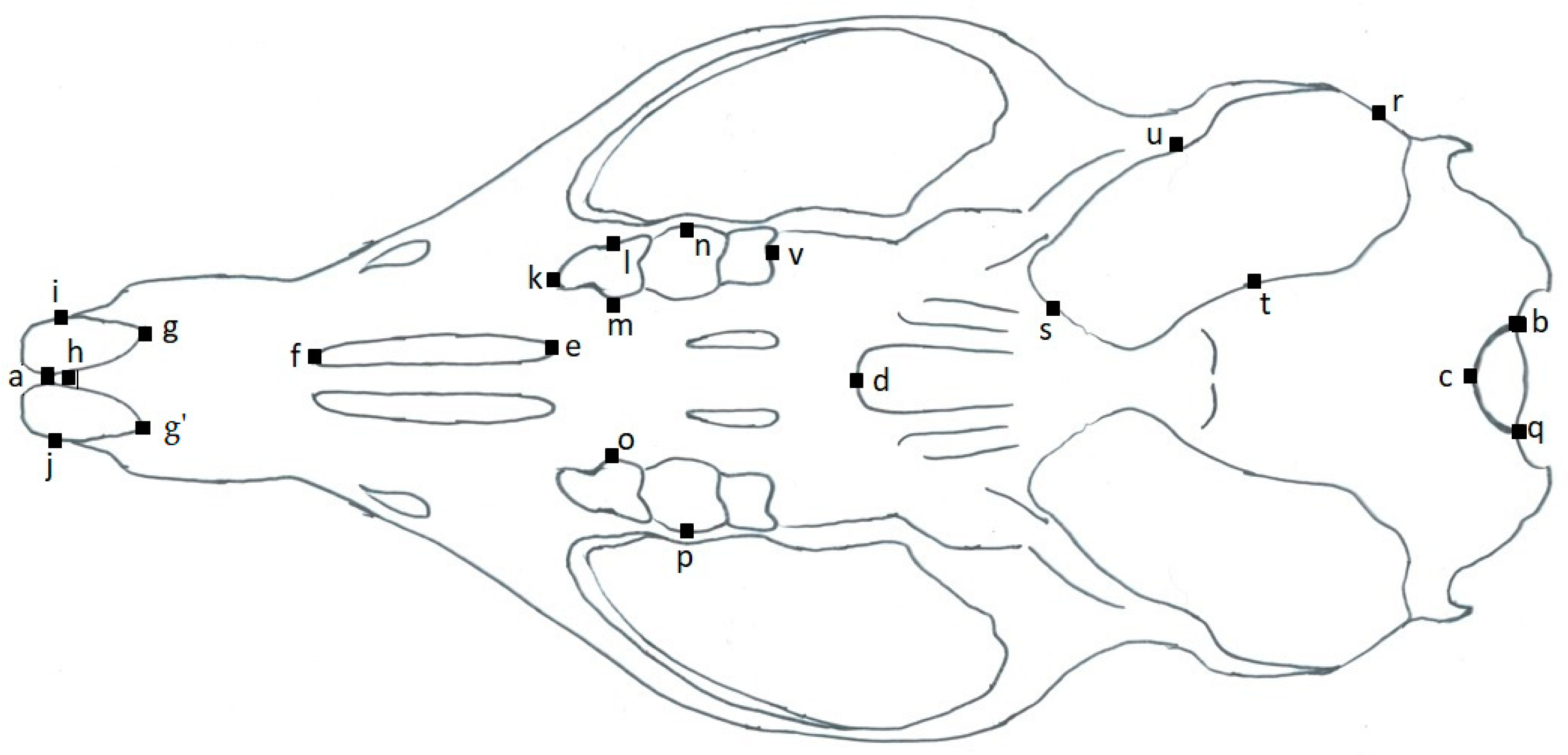
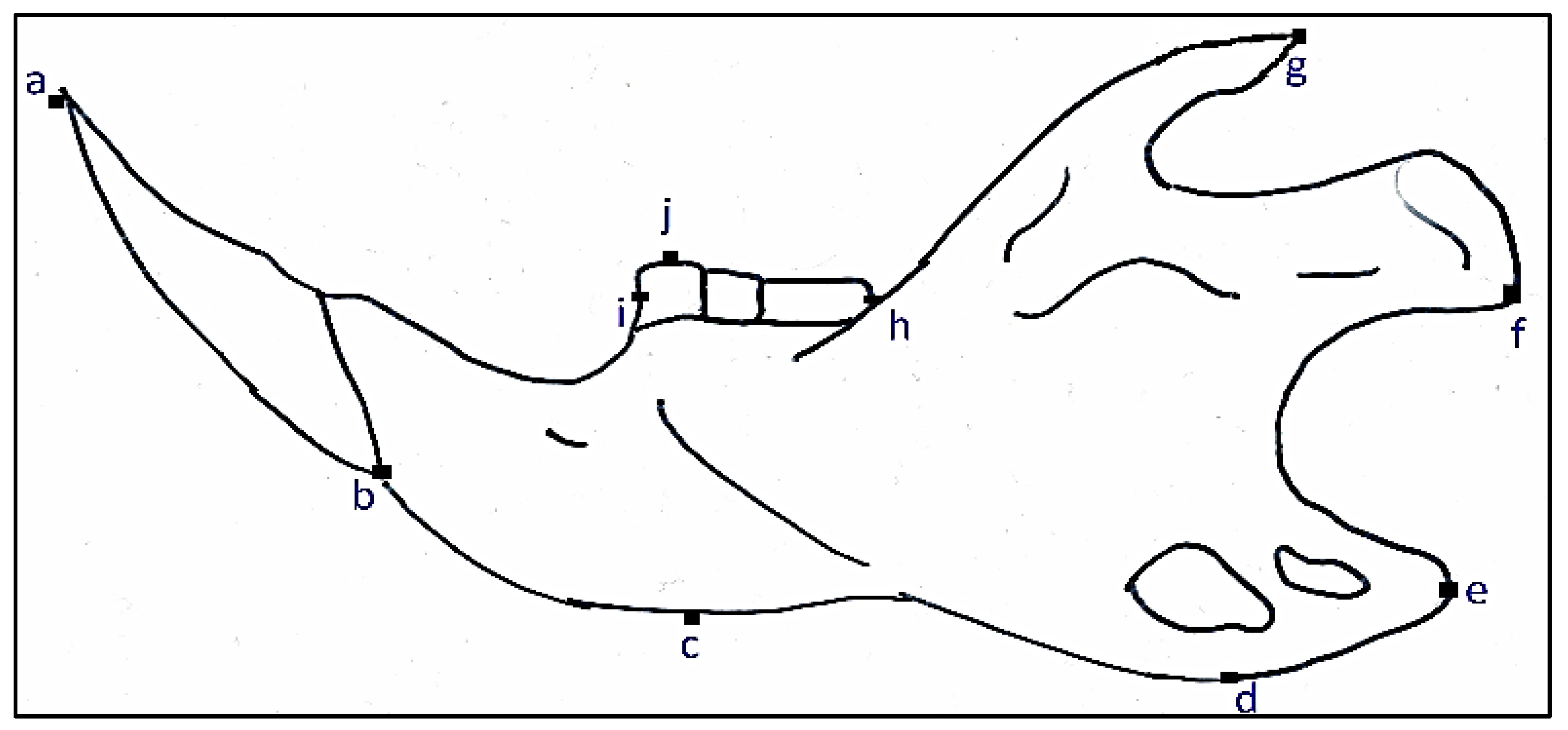
| Characters | n (% of Total Capture, 95% CI) |
|---|---|
| Trapping location (n = 148) | |
| Agriculture farm | 31 (20.9, 14.69–28.39) |
| Bachelor residence | 18 (12.2, 7.36–18.53) |
| Commercial area | 11 (7.4, 3.76–12.91) |
| Family residence | 11 (7.4, 3.76–12.91) |
| Industrial area | 4 (2.7, 0.74–6.78) |
| Livestock farms | 73 (49.3, 41.02–57.65) |
| Municipalities (n = 148) | |
| Al Khore | 17 (11.5, 6.84–17.75) |
| Daayan | 1 (0.7, 0.002–0.37) |
| Doha | 10 (6.8, 3.29–12.07) |
| Rayyan | 92 (62.2, 58.83–69.70) |
| Shamal | 7 (4.7, 1.92–9.50) |
| Um Salal | 8 (5.4, 2.36–10.37) |
| Wakrah | 13 (8.8, 41.02–57.65) |
| Species (n = 148) | |
| Mus musculus | 4 (2.7, 0.74–6.78) |
| Rattus norvegicus | 120 (81.1, 73.83–87.05) |
| Rattus rattus | 24 (16.2, 10.68–23.16) |
| Sex (n = 148) | |
| Female | 75 (50.7, 42.34–58.98) |
| Male | 73 (49.3, 41.02–57.65) |
| Pregnancy (n = 75) | |
| Pregnant | 20 (26.7, 17.11–38.14) |
| Non-pregnant | 55 (73.3, 61.86–82.89) |
| Age (n = 148) | |
| Adult | 138 (93.2, 87.92–96.71) |
| Young | 10 (6.8, 3.29–12.07) |
| Sl. No. | Parameters * | Mus musculus (n = 4) | Rattus norvegicus (n = 120) | Rattus rattus (n = 24) |
|---|---|---|---|---|
| 1 | Body weight | 18.8 ± 2.2 | 264.3 ± 87.5 | 130.0 ± 71.3 |
| 2 | General length | 163.8 ± 4.8 | 398.5 ± 45.1 | 324.4 ± 80.0 |
| 3 | Tail length | 85.3 ± 4.1 | 191.4 ± 22.9 | 181.3 ± 39.0 |
| 4 | Body length | 78.5 ± 2.4 | 207.1 ± 23.0 | 143.1 ± 44.4 |
| 5 | Right ear length | 13.3 ± 1.7 | 18.9 ± 1.7 | 18.6 ± 2.1 |
| 6 | Right hind leg length | 16.5 ± 1.3 | 39.2 ± 3.6 | 32.4 ± 3.9 |
| Sl. No. | Parameters * | Mus musculus (n = 4) | Rattus norvegicus (n = 86) | Rattus rattus (n = 18) |
|---|---|---|---|---|
| 1 | General cranial length | 21.9 ± 0.4 | 46.8 ± 4.1 | 37.2 ± 2.7 |
| 2 | Condylobasal length | 21.3 ± 0.1 | 45.2 ± 4.1 | 35.5 ± 2.9 |
| 3 | Henselion-basion length | 18.7 ± 0.4 | 39.1 ± 3.6 | 29.4 ± 2.9 |
| 4 | Henselion-palpation length | 11.2 ± 1.3 | 22.4 ± 2.3 | 16.9 ± 1.7 |
| 5 | Length of upper incisor | 3.3 ± 0.6 | 7.5 ± 1.6 | 5.6 ± 1.0 |
| 6 | Width of upper incisors, basal | 2.1 ± 0.2 | 4.8 ± 0.6 | 3.5 ± 0.5 |
| 7 | Width of upper incisors, apex | 1.3 ± 0.1 | 3.3 ± 0.5 | 2.2 ± 0.4 |
| 8 | Upper incisor to alveolus molar tooth 1 | 6.3 ± 0.4 | 14.4 ± 1.9 | 10.1 ± 1.4 |
| 9 | Length of diastema | 5.9 ± 0.4 | 13.4 ± 1.5 | 9.6 ± 1.2 |
| 10 | Nasal bone length | 7.5 ± 0.6 | 17.2 ± 1.9 | 12.6 ± 1.4 |
| 11 | Breath of nasal bones | 2.2 ± 0.4 | 5.2 ± 0.6 | 3.9 ± 0.3 |
| 12 | Frontal bone length | 7.1 ± 0.4 | 14.7 ± 1.3 | 12.2 ± 1.4 |
| 13 | Frontal bone width | 5.7 ± 1.1 | 10.9 ± 0.6 | 10.3 ± 1.1 |
| 14 | Parietal bone length | 7.3 ± 0.5 | 13.0 ± 1.1 | 11.2 ± 1.0 |
| 15 | Breath of brain cage | 9.8 ± 0.4 | 16.4 ± 2.1 | 16.2 ± 0.6 |
| 16 | Interparietal bone length | 3.2 ± 0.2 | 6.5 ± 0.7 | 5.5 ± 0.6 |
| 17 | Interparietal bone width | 6.7 ± 1.5 | 11.5 ± 1.0 | 10.7 ± 0.8 |
| 18 | Occipital bone length | 4.5 ± 0.4 | 6.0 ± 0.8 | 4.5 ± 0.4 |
| 19 | General cranial height | 7.4 ± 0.1 | 16.6 ± 1.5 | 13.7 ± 0.8 |
| 20 | Rostrum height | 6.3 ± 0.3 | 13.8 ± 1.3 | 10.8 ± 0.9 |
| 21 | Rostrum breathe | 3.5 ± 0.1 | 9.0 ± 1.0 | 6.5 ± 0.7 |
| 22 | Smallest interorbital breadth | 3.4 ± 0.3 | 6.8 ± 0.5 | 5.8 ± 0.4 |
| 23 | Breath of Inferior ramus of the zygomatic process of maxillary | 0.9 ± 0.2 | 1.9 ± 0.3 | 1.5 ± 0.2 |
| 24 | Breath of base zygomatic process of squamosal | 1.5 ± 0.2 | 3.0 ± 0.4 | 2.2 ± 0.4 |
| 25 | Breadth of zygomatic plate | 2.5 ± 0.2 | 5.1 ± 0.6 | 3.7 ± 0.6 |
| 26 | Zygomatic breath | 11.0 ± 0.5 | 22.4 ± 2.3 | 18.2 ± 1.0 |
| 27 | Length of palatal foramen | 4.1 ± 0.6 | 7.8 ± 0.8 | 6.1 ± 0.9 |
| 28 | Smallest palatal breadth | 2.1 ± 0.3 | 4.7 ± 0.6 | 3.6 ± 0.4 |
| 29 | Upper cheek-teeth alveoli | 3.4 ± 0.4 | 7.4 ± 0.4 | 6.7 ± 0.4 |
| 30 | Breadth of upper dental arch | 4.4 ± 0.2 | 9.4 ± 0.7 | 7.6 ± 0.4 |
| 31 | Breadth of molar tooth 1 | 1.1 ± 0.1 | 2.8 ± 1.0 | 2.0 ± 0.2 |
| 32 | Tympanic bulla length | 2.4 ± 0.3 | 8.1 ± 0.6 | 7.1 ± 0.5 |
| 33 | Tympanic bulla width | 3.2 ± 0.1 | 6.0 ± 1.0 | 5.2 ± 0.6 |
| 34 | Foramen magnum width | 3.6 ± 0.3 | 6.9 ± 0.4 | 5.9 ± 0.3 |
| Sl. No. | Parameters * | Mus musculus (n = 4) | Rattus norvegicus (n = 86) | Rattus rattus (n = 18) |
|---|---|---|---|---|
| 1 | Length of lower incisors | 3.8 ± 0.5 | 9.5 ± 2.0 | 6.9 ± 1.2 |
| 2 | Lower incisors to coronoid process | 10.8 ± 0.1 | 25.4 ± 2.6 | 19.2 ± 2.2 |
| 3 | Lower incisors to condylar process | 13.4 ± 0.2 | 30.2 ± 2.9 | 23.4 ± 2.2 |
| 4 | Lower incisors to angular process | 13.5 ± 0.3 | 30.5 ± 3.1 | 23.7 ± 2.3 |
| 5 | Greatest jaw height | 6.6 ± 0.2 | 14.3 ± 1.6 | 11.1 ± 1.0 |
| 6 | Ramus to molar tooth 1 | 3.8 ± 0.1 | 8.8 ± 1.0 | 6.6 ± 0.7 |
| 7 | Lower molar tooth 1- molar tooth 3 | 3.3 ± 0.3 | 7.3 ± 0.3 | 6.3 ± 0.5 |
| 8 | Lower incisors to molar tooth 1 | 5.0 ± 0.3 | 11.4 ± 1.4 | 8.6 ± 1.0 |
| Sl. No. | Parameters * | Rattus norvegicus | Rattus rattus | ||||
|---|---|---|---|---|---|---|---|
| Female (n = 62) | Male (n = 58) | p | Female (n = 10) | Male (n = 14) | p | ||
| 1 | Body weight | 260.6 ± 76.1 | 268.2 ± 98.8 | 0.64 | 128.5 ± 65.7 | 131.0 ± 77.6 | 0.93 |
| 2 | General length | 396.5 ± 37.8 | 400.5 ± 52.0 | 0.63 | 342.5 ± 72.8 | 311.4 ± 85.0 | 0.36 |
| 3 | Tail length | 190.2 ± 18.8 | 192.7 ± 26.8 | 0.55 | 192.0 ± 42.0 | 173.6 ± 36.3 | 0.26 |
| 4 | Body length | 206.4 ± 20.1 | 207.8 ± 25.9 | 0.73 | 150.3 ± 33.1 | 137.9 ± 51.6 | 0.50 |
| 5 | Right ear length | 18.7 ± 1.7 | 19.0 ± 1.7 | 0.39 | 19.6 ± 1.8 | 17.9 ± 2.0 | 0.04 |
| 6 | Right hind leg length | 38.7 ± 2.9 | 39.8 ± 4.2 | 0.09 | 32.0 ± 2.0 | 32.6 ± 4.9 | 0.70 |
| Sl. No. | Parameters * | Rattus norvegicus | Rattus rattus | ||||
|---|---|---|---|---|---|---|---|
| Female (n = 38) | Male (n = 48) | p | Female (n = 9) | Male (n = 9) | p | ||
| 1 | General cranial length | 46.3 ± 3.7 | 47.1 ± 4.3 | 0.38 | 38.2 ± 2.8 | 36.2 ± 2.2 | 0.11 |
| 2 | Condylobasal length | 44.8 ± 3.6 | 45.5 ± 4.4 | 0.48 | 35.3 ± 3.5 | 35.6 ± 2.3 | 0.83 |
| 3 | Henselion-basion length | 39.3 ± 3.5 | 38.9 ± 3.8 | 0.65 | 29.5 ± 3.8 | 29.2 ± 1.8 | 0.82 |
| 4 | Henselion-palpation length | 22.6 ± 1.9 | 22.2 ± 2.6 | 0.51 | 17.3 ± 1.4 | 16.4 ± 2.0 | 0.25 |
| 5 | Length of upper incisor | 7.5 ± 1.6 | 7.5 ± 1.6 | 0.95 | 5.8 ± 1.1 | 5.4 ± 0.9 | 0.38 |
| 6 | Width of upper incisors, basal | 4.8 ± 0.6 | 4.8 ± 0.6 | 0.77 | 3.6 ± 0.3 | 3.4 ± 0.7 | 0.40 |
| 7 | Width of upper incisors, apex | 3.2 ± 0.5 | 3.3 ± 0.4 | 0.31 | 2.4 ± 0.2 | 2.1 ± 0.4 | 0.08 |
| 8 | Upper incisor to alveolus molar tooth 1 | 14.4 ± 1.8 | 14.4 ± 2.0 | 0.99 | 10.8 ± 1.3 | 9.5 ± 1.4 | 0.06 |
| 9 | Length of diastema | 13.3 ± 1.5 | 13.4 ± 1.5 | 0.77 | 10.2 ± 1.1 | 9.1 ± 1.2 | 0.06 |
| 10 | Nasal bone length | 17.2 ± 1.8 | 17.2 ± 2.0 | 0.89 | 13.0 ± 1.3 | 12.2 ± 1.4 | 0.24 |
| 11 | Breath of nasal bones | 5.1 ± 0.5 | 5.2 ± 0.6 | 0.30 | 4.0 ± 0.1 | 3.8 ± 0.4 | 0.38 |
| 12 | Frontal bone length | 14.6 ± 1.1 | 14.7 ± 1.5 | 0.72 | 12.8 ± 1.5 | 11.7 ± 1.1 | 0.13 |
| 13 | Frontal bone width | 10.8 ± 0.6 | 10.9 ± 0.6 | 0.55 | 10.4 ± 1.2 | 10.2 ± 0.9 | 0.63 |
| 14 | Parietal bone length | 13.0 ± 0.9 | 13.1 ± 1.2 | 0.75 | 11.6 ± 0.6 | 10.9 ± 1.2 | 0.16 |
| 15 | Breath of brain cage | 16.1 ± 2.0 | 16.6 ± 2.3 | 0.33 | 16.1 ± 0.6 | 16.3 ± 0.7 | 0.48 |
| 16 | Interparietal bone length | 6.6 ± 0.9 | 6.4 ± 0.6 | 0.24 | 5.6 ± 0.5 | 5.4 ± 0.7 | 0.51 |
| 17 | Interparietal bone width | 11.4 ± 1.0 | 11.6 ± 1.0 | 0.20 | 10.8 ± 0.8 | 10.6 ± 0.9 | 0.79 |
| 18 | Occipital bone length | 6.0 ± 0.7 | 6.0 ± 0.9 | 0.75 | 4.5 ± 0.5 | 4.5 ± 0.2 | 0.86 |
| 19 | General cranial height | 16.6 ± 1.6 | 16.6 ± 1.5 | 0.97 | 14.1 ± 0.7 | 13.2 ± 0.8 | 0.03 |
| 20 | Rostrum height | 13.8 ± 1.1 | 13.7 ± 1.4 | 0.72 | 11.2 ± 0.7 | 10.4 ± 1.0 | 0.07 |
| 21 | Rostrum breathe | 9.1 ± 0.9 | 9.0 ± 1.1 | 0.74 | 6.7 ± 0.6 | 6.4 ± 0.8 | 0.41 |
| 22 | Smallest interorbital breadth | 6.7 ± 0.4 | 6.9 ± 0.6 | 0.32 | 6.0 ± 0.4 | 5.6 ± 0.3 | 0.04 |
| 23 | Breath of inferior ramus of the zygomatic process of maxillary | 1.8 ± 0.3 | 1.9 ± 0.3 | 0.11 | 1.6 ± 0.2 | 1.4 ± 0.1 | 0.09 |
| 24 | Breath of base zygomatic process of squamosal | 2.9 ± 0.4 | 3.0 ± 0.4 | 0.70 | 2.3 ± 0.4 | 2.1 ± 0.5 | 0.40 |
| 25 | Breadth of zygomatic plate | 5.2 ± 0.5 | 5.0 ± 0.6 | 0.34 | 4.0 ± 0.3 | 3.5 ± 0.8 | 0.08 |
| 26 | Zygomatic breath | 22.4 ± 2.0 | 22.3 ± 2.5 | 0.82 | 18.5 ± 0.8 | 17.9 ± 1.2 | 0.25 |
| 27 | Length of palatal foramen | 7.9 ± 0.7 | 7.8 ± 0.9 | 0.60 | 6.0 ± 1.0 | 6.1 ± 0.8 | 0.69 |
| 28 | Smallest palatal breadth | 4.8 ± 0.6 | 4.6 ± 0.5 | 0.29 | 3.8 ± 0.4 | 3.4 ± 0.4 | 0.06 |
| 29 | Upper cheek-teeth alveoli | 7.3 ± 0.4 | 7.4 ± 0.4 | 0.16 | 6.6 ± 0.4 | 6.7 ± 0.4 | 0.55 |
| 30 | Breadth of upper dental arch | 9.4 ± 0.7 | 9.4 ± 0.7 | 0.57 | 7.8 ± 0.3 | 7.5 ± 0.5 | 0.19 |
| 31 | Breadth of molar tooth 1 | 2.8 ± 1.0 | 2.7 ± 1.0 | 0.84 | 2.0 ± 0.3 | 2.0 ± 0.2 | 0.65 |
| 32 | Tympanic bulla length | 8.1 ± 0.5 | 8.1 ± 0.7 | 0.76 | 7.1 ± 0.6 | 7.1 ± 0.5 | 0.91 |
| 33 | Tympanic bulla width | 6.1 ± 1.1 | 6.0 ± 0.9 | 0.78 | 5.2 ± 0.7 | 5.2 ± 0.6 | 0.99 |
| 34 | Foramen magnum width | 6.8 ± 0.4 | 6.9 ± 0.4 | 0.08 | 6.0 ± 0.3 | 5.8 ± 0.2 | 0.39 |
| Sl. No. | Parameters * | Rattus norvegicus | Rattus rattus | ||||
|---|---|---|---|---|---|---|---|
| Female (n = 38) | Male (n = 48) | p | Female (n = 9) | Male (n = 9) | p | ||
| 1 | Length of lower incisors | 9.4 ± 1.9 | 9.6 ± 2.2 | 0.73 | 7.6 ± 1.1 | 6.3 ± 1.1 | 0.02 |
| 2 | Lower incisors to coronoid process | 25.1 ± 2.1 | 25.6 ± 2.9 | 0.34 | 20.6 ± 1.3 | 17.7 ± 1.9 | 0.01 |
| 3 | Lower incisors to condylar process | 30.4 ± 3.0 | 30.0 ± 2.9 | 0.57 | 24.8 ± 1.3 | 22.1 ± 2.1 | 0.01 |
| 4 | Lower incisors to angular process | 30.6 ± 3.0 | 30.4 ± 3.2 | 0.69 | 25.0 ± 1.4 | 22.3 ± 2.3 | 0.01 |
| 5 | Greatest jaw height | 14.4 ± 1.6 | 14.3 ± 1.6 | 0.71 | 11.6 ± 1.0 | 10.7 ± 0.8 | 0.06 |
| 6 | Ramus to molar tooth 1 | 8.8 ± 1.1 | 8.7 ± 0.9 | 0.70 | 7.1 ± 0.5 | 6.2 ± 0.6 | 0.01 |
| 7 | Lower molar tooth 1- molar tooth 3 | 7.3 ± 0.3 | 7.3 ± 0.3 | 0.84 | 6.3 ± 0.4 | 6.4 ± 0.7 | 0.80 |
| 8 | Lower incisors to molar tooth 1 | 11.3 ± 1.2 | 11.4 ± 1.5 | 0.63 | 9.3 ± 0.8 | 8.0 ± 0.8 | 0.01 |
| Sl. No. | Parameters * | Rattus norvegicus | Rattus rattus | ||||
|---|---|---|---|---|---|---|---|
| Pregnant (n = 16) | Non-Pregnant (n = 45) | p | Pregnant (n = 8) | Non-Pregnant (n = 2) | p | ||
| 1 | Body weight | 275.3 ± 88.0 | 260.0 ± 65.6 | 0.47 | 111.5 ± 28.9 | 196.5 ± 146.4 | 0.10 |
| 2 | General length | 400.6 ± 31.1 | 398.3 ± 33.9 | 0.81 | 348.8 ± 68.1 | 317.5 ± 116.7 | 0.62 |
| 3 | Tail length | 190.6 ± 15.5 | 191.6 ± 17.1 | 0.85 | 196.9 ± 42.8 | 172.5 ± 46.0 | 0.50 |
| 4 | Body length | 210.0 ± 17.6 | 206.8 ± 17.7 | 0.53 | 151.9 ± 26.2 | 145.0 ± 70.1 | 0.81 |
| 5 | Right ear length | 18.9 ± 1.9 | 18.7 ± 1.7 | 0.78 | 19.8 ± 2.0 | 19.0 ± 1.4 | 0.63 |
| 6 | Right hind leg length | 38.3 ± 3.6 | 39.0 ± 2.3 | 0.37 | 31.4 ± 1.1 | 34.5 ± 3.5 | 0.04 |
| Sl. No. | Parameters * | Rattus norvegicus | Rattus rattus | ||||
|---|---|---|---|---|---|---|---|
| Pregnant (n = 11) | Non-Pregnant (n = 27) | p | Pregnant (n = 7) | Non-Pregnant (n = 2) | p | ||
| 1 | General cranial length | 46.0 ± 3.8 | 46.5 ± 3.8 | 0.74 | 38.7 ± 3.1 | 36.7 ± 0.3 | 0.41 |
| 2 | Condylobasal length | 44.6 ± 3.8 | 45.0 ± 3.6 | 0.77 | 36.0 ± 3.8 | 33.0 ± 1.4 | 0.34 |
| 3 | Henselion-basion length | 39.4 ± 3.4 | 39.2 ± 3.6 | 0.88 | 30.2 ± 3.8 | 27.2 ± 4.2 | 0.36 |
| 4 | Henselion-palpation length | 22.7 ± 2.1 | 22.5 ± 1.9 | 0.76 | 17.4 ± 1.6 | 17.0 ± 0.8 | 0.73 |
| 5 | Length of upper incisor | 7.8 ± 1.0 | 7.4 ± 1.9 | 0.53 | 5.8 ± 1.3 | 5.8 ± 0.1 | 0.99 |
| 6 | Width of upper incisors, basal | 4.7 ± 0.7 | 4.8 ± 0.6 | 0.75 | 3.6 ± 0.2 | 3.6 ± 0.5 | 0.66 |
| 7 | Width of upper incisors, apex | 3.1 ± 0.5 | 3.2 ± 0.5 | 0.47 | 2.4 ± 0.2 | 2.2 ± 0.1 | 0.19 |
| 8 | Upper incisor to alveolus molar tooth 1 | 14.7 ± 1.1 | 14.2 ± 2.0 | 0.43 | 11.0 ± 1.2 | 9.8 ± 1.2 | 0.26 |
| 9 | Length of diastema | 13.3 ± 1.6 | 13.3 ± 1.4 | 0.94 | 10.4 ± 1.1 | 9.4 ± 0.8 | 0.29 |
| 10 | Nasal bone length | 17.2 ± 2.0 | 17.2 ± 1.8 | 0.97 | 13.3 ± 1.4 | 12.2 ± 0.3 | 0.32 |
| 11 | Breath of nasal bones | 5.1 ± 0.5 | 5.1 ± 0.6 | 0.90 | 4.0 ± 0.2 | 4.1 ± 0.1 | 0.32 |
| 12 | Frontal bone length | 14.3 ± 1.0 | 14.7 ± 1.2 | 0.27 | 12.9 ± 1.7 | 12.2 ± 0.7 | 0.61 |
| 13 | Frontal bone width | 10.9 ± 0.6 | 10.8 ± 0.6 | 0.87 | 10.7 ± 1.3 | 9.4 ± 0.1 | 0.19 |
| 14 | Parietal bone length | 12.9 ± 0.3 | 13.1 ± 1.1 | 0.61 | 11.6 ± 0.7 | 11.5 ± 0.3 | 0.83 |
| 15 | Breath of brain cage | 16.5 ± 0.9 | 16.0 ± 2.3 | 0.49 | 16.1 ± 0.7 | 16.0 ± 0.4 | 0.81 |
| 16 | Interparietal bone length | 6.6 ± 1.0 | 6.6 ± 0.8 | 0.84 | 5.6 ± 0.5 | 5.8 ± 0.6 | 0.59 |
| 17 | Interparietal bone width | 11.0 ± 0.8 | 11.5 ± 1.0 | 0.19 | 10.8 ± 0.8 | 10.5 ± 1.3 | 0.59 |
| 18 | Occipital bone length | 5.8 ± 0.8 | 6.1 ± 0.6 | 0.20 | 4.4 ± 0.5 | 4.9 ± 0.3 | 0.21 |
| 19 | General cranial height | 16.3 ± 1.6 | 16.7 ± 1.7 | 0.49 | 14.0 ± 0.7 | 14.3 ± 0.9 | 0.67 |
| 20 | Rostrum height | 13.6 ± 1.3 | 13.9 ± 1.1 | 0.41 | 11.2 ± 0.8 | 11.0 ± 0.2 | 0.77 |
| 21 | Rostrum breathe | 9.0 ± 0.9 | 9.1 ± 0.9 | 0.68 | 6.8 ± 0.7 | 6.5 ± 0.2 | 0.61 |
| 22 | Smallest interorbital breadth | 6.6 ± 0.5 | 6.8 ± 0.4 | 0.21 | 6.1 ± 0.5 | 5.8 ± 0.1 | 0.44 |
| 23 | Breath of inferior ramus of the zygomatic process of maxillary | 1.8 ± 0.3 | 1.9 ± 0.3 | 0.26 | 1.6 ± 0.3 | 1.5 ± 0.1 | 0.63 |
| 24 | Breath of base zygomatic process of squamosal | 3.0 ± 0.5 | 2.9 ± 0.4 | 0.63 | 2.4 ± 0.4 | 2.0 ± 0.2 | 0.21 |
| 25 | Breadth of zygomatic plate | 5.2 ± 0.4 | 5.2 ± 0.5 | 0.89 | 4.0 ± 0.4 | 4.1 ± 0.2 | 0.63 |
| 26 | Zygomatic breath | 22.5 ± 1.7 | 22.4 ± 2.2 | 0.91 | 18.6 ± 0.8 | 17.9 ± 0.6 | 0.34 |
| 27 | Length of palatal foramen | 7.9 ± 0.7 | 7.9 ± 0.6 | 0.82 | 5.9 ± 1.2 | 6.1 ± 0.1 | 0.88 |
| 28 | Smallest palatal breadth | 4.7 ± 0.6 | 4.8 ± 0.5 | 0.54 | 3.9 ± 0.4 | 3.3 ± 0.2 | 0.06 |
| 29 | Upper cheek-teeth alveoli | 7.3 ± 0.5 | 7.4 ± 0.3 | 0.41 | 6.5 ± 0.4 | 6.9 ± 0.4 | 0.21 |
| 30 | Breadth of upper dental arch | 9.3 ± 0.8 | 9.5 ± 0.7 | 0.53 | 7.8 ± 0.3 | 7.8 ± 0.4 | 0.78 |
| 31 | Breadth of molar tooth 1 | 2.8 ± 1.1 | 2.8 ± 1.0 | 0.98 | 2.0 ± 0.3 | 2.2 ± 0.2 | 0.26 |
| 32 | Tympanic bulla length | 8.1 ± 0.4 | 8.1 ± 0.5 | 0.99 | 7.2 ± 0.7 | 6.6 ± 0.1 | 0.25 |
| 33 | Tympanic bulla width | 6.1 ± 1.3 | 6.0 ± 1.0 | 0.77 | 5.4 ± 0.6 | 4.4 ± 0.2 | 0.05 |
| 34 | Foramen magnum width | 6.5 ± 0.4 | 6.9 ± 0.4 | 0.05 | 38.7 ± 3.1 | 6.1 ± 0.5 | 0.47 |
| Sl. No. | Parameters * | Rattus norvegicus | Rattus rattus | ||||
|---|---|---|---|---|---|---|---|
| Pregnant (n = 11) | Non-Pregnant (n = 27) | p | Pregnant (n = 7) | Non-Pregnant (n = 2) | p | ||
| 1 | Length of lower incisors | 9.5 ± 1.1 | 9.4 ± 2.2 | 0.90 | 7.7 ± 1.2 | 7.2 ± 0.4 | 0.64 |
| 2 | Lower incisors to coronoid process | 24.9 ± 2.2 | 25.1 ± 2.1 | 0.75 | 20.9 ± 1.3 | 19.6 ± 0.5 | 0.19 |
| 3 | Lower incisors to condylar process | 30.1 ± 2.6 | 30.5 ± 3.1 | 0.70 | 25.1 ± 1.2 | 23.4 ± 0.3 | 0.10 |
| 4 | Lower incisors to angular process | 30.3 ± 2.8 | 30.8 ± 3.1 | 0.63 | 25.5 ± 1.2 | 23.4 ± 0.1 | 0.05 |
| 5 | Greatest jaw height | 14.0 ± 1.5 | 14.6 ± 1.6 | 0.35 | 11.8 ± 1.0 | 10.8 ± 0.8 | 0.23 |
| 6 | Ramus to molar tooth M1 | 8.5 ± 1.2 | 9.0 ± 1.0 | 0.28 | 7.2 ± 0.5 | 6.7 ± 0.3 | 0.24 |
| 7 | Lower molar tooth M1- molar tooth 3 | 7.2 ± 0.3 | 7.4 ± 0.3 | 0.13 | 6.2 ± 0.4 | 6.6 ± 0.1 | 0.19 |
| 8 | Lower incisors to molar tooth 1 | 11.1 ± 1.1 | 11.4 ± 1.3 | 0.57 | 9.5 ± 0.7 | 8.4 ± 0.8 | 0.12 |
Publisher’s Note: MDPI stays neutral with regard to jurisdictional claims in published maps and institutional affiliations. |
© 2021 by the authors. Licensee MDPI, Basel, Switzerland. This article is an open access article distributed under the terms and conditions of the Creative Commons Attribution (CC BY) license (https://creativecommons.org/licenses/by/4.0/).
Share and Cite
Islam, M.M.; Farag, E.; Mahmoudi, A.; Hassan, M.M.; Atta, M.; Mostafavi, E.; Alnager, I.A.; Farrag, H.A.; Eljack, G.E.A.; Bansal, D.; et al. Morphometric Study of Mus musculus, Rattus norvegicus, and Rattus rattus in Qatar. Animals 2021, 11, 2162. https://doi.org/10.3390/ani11082162
Islam MM, Farag E, Mahmoudi A, Hassan MM, Atta M, Mostafavi E, Alnager IA, Farrag HA, Eljack GEA, Bansal D, et al. Morphometric Study of Mus musculus, Rattus norvegicus, and Rattus rattus in Qatar. Animals. 2021; 11(8):2162. https://doi.org/10.3390/ani11082162
Chicago/Turabian StyleIslam, Md Mazharul, Elmoubashar Farag, Ahmad Mahmoudi, Mohammad Mahmudul Hassan, Muzzamil Atta, Ehsan Mostafavi, Ismail Alnour Alnager, Hassan Ali Farrag, Gaafar El Awad Eljack, Devendra Bansal, and et al. 2021. "Morphometric Study of Mus musculus, Rattus norvegicus, and Rattus rattus in Qatar" Animals 11, no. 8: 2162. https://doi.org/10.3390/ani11082162
APA StyleIslam, M. M., Farag, E., Mahmoudi, A., Hassan, M. M., Atta, M., Mostafavi, E., Alnager, I. A., Farrag, H. A., Eljack, G. E. A., Bansal, D., Haroun, M., Abdeen, R., Al-Romaihi, H., Al-Zeyara, A. A., Almalki, S. A., & Mkhize-Kwitshana, Z. (2021). Morphometric Study of Mus musculus, Rattus norvegicus, and Rattus rattus in Qatar. Animals, 11(8), 2162. https://doi.org/10.3390/ani11082162










